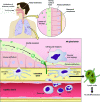Innate immunity to Aspergillus species
- PMID: 19822887
- PMCID: PMC2772361
- DOI: 10.1128/CMR.00014-09
Innate immunity to Aspergillus species
Abstract
All humans are continuously exposed to inhaled Aspergillus conidia, yet healthy hosts clear the organism without developing disease and without the development of antibody- or cell-mediated acquired immunity to this organism. This suggests that for most healthy humans, innate immunity is sufficient to clear the organism. A failure of these defenses results in a uniquely diverse set of illnesses caused by Aspergillus species, which includes diseases caused by the colonization of the respiratory tract, invasive infection, and hypersensitivity. A key concept in immune responses to Aspergillus species is that the susceptibilities of the host determine the morphological form, antigenic structure, and physical location of the fungus. In this review, we summarize the current literature on the multiple layers of innate defenses against Aspergillus species that dictate the outcome of this host-microbe interaction.
Figures



References
-
- Aderem, A., and D. M. Underhill. 1999. Mechanisms of phagocytosis in macrophages. Annu. Rev. Immunol. 17:593-623. - PubMed
-
- Ahlin, A., G. Elinder, and J. Palmblad. 1997. Dose-dependent enhancements by interferon-gamma on functional responses of neutrophils from chronic granulomatous disease patients. Blood 89:3396-3401. - PubMed
-
- Alles, V. V., B. Bottazzi, G. Peri, J. Golay, M. Introna, and A. Mantovani. 1994. Inducible expression of PTX3, a new member of the pentraxin family, in human mononuclear phagocytes. Blood 84:3483-3493. - PubMed
-
- Aratani, Y., F. Kura, H. Watanabe, H. Akagawa, Y. Takano, K. Suzuki, M. C. Dinauer, N. Maeda, and H. Koyama. 2002. Relative contributions of myeloperoxidase and NADPH-oxidase to the early host defense against pulmonary infections with Candida albicans and Aspergillus fumigatus. Med. Mycol. 40:557-563. - PubMed
Publication types
MeSH terms
Grants and funding
LinkOut - more resources
Full Text Sources
Medical

